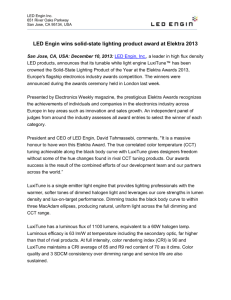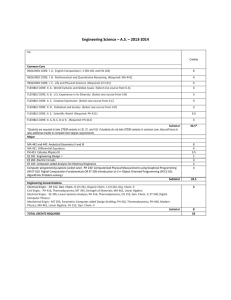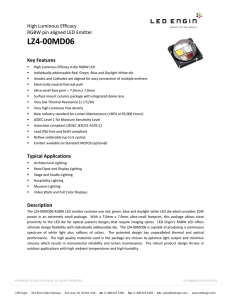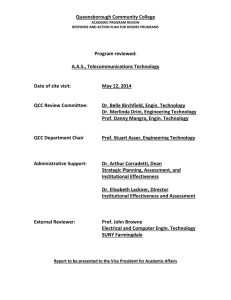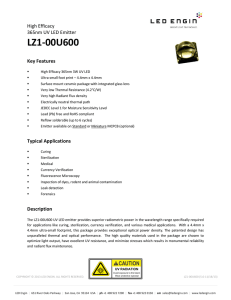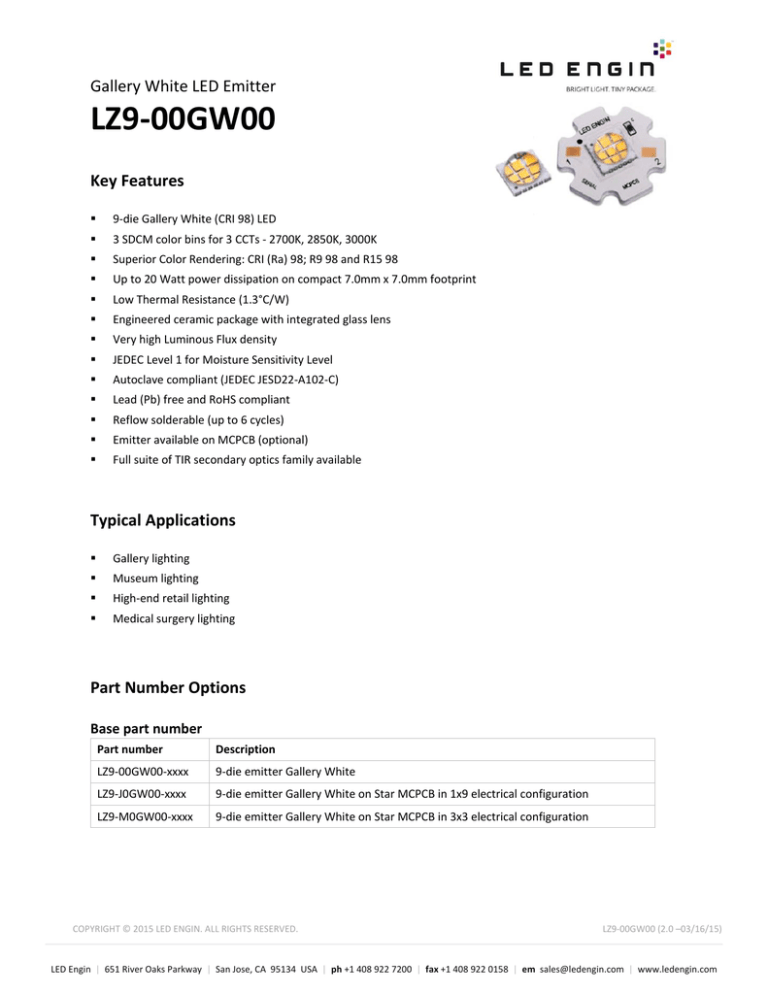
Gallery White LED Emitter
LZ9-00GW00
Key Features
9-die Gallery White (CRI 98) LED
3 SDCM color bins for 3 CCTs - 2700K, 2850K, 3000K
Superior Color Rendering: CRI (Ra) 98; R9 98 and R15 98
Up to 20 Watt power dissipation on compact 7.0mm x 7.0mm footprint
Low Thermal Resistance (1.3°C/W)
Engineered ceramic package with integrated glass lens
Very high Luminous Flux density
JEDEC Level 1 for Moisture Sensitivity Level
Autoclave compliant (JEDEC JESD22-A102-C)
Lead (Pb) free and RoHS compliant
Reflow solderable (up to 6 cycles)
Emitter available on MCPCB (optional)
Full suite of TIR secondary optics family available
Typical Applications
Gallery lighting
Museum lighting
High-end retail lighting
Medical surgery lighting
Part Number Options
Base part number
Part number
Description
LZ9-00GW00-xxxx
9-die emitter Gallery White
LZ9-J0GW00-xxxx
9-die emitter Gallery White on Star MCPCB in 1x9 electrical configuration
LZ9-M0GW00-xxxx
9-die emitter Gallery White on Star MCPCB in 3x3 electrical configuration
COPYRIGHT © 2015 LED ENGIN. ALL RIGHTS RESERVED.
LZ9-00GW00 (2.0 –03/16/15)
LED Engin | 651 River Oaks Parkway | San Jose, CA 95134 USA | ph +1 408 922 7200 | fax +1 408 922 0158 | em sales@ledengin.com | www.ledengin.com
Bin Kit Option Codes
GW, Gallery White (CRI 98)
Kit number
suffix
Min
flux
Bin
Color Bin Ranges
Description
0027
W
3-step MacAdams ellipse
full distribution flux; 2700K ANSI CCT
0028
W
3-step MacAdams ellipse
full distribution flux; 2850K ANSI CCT
0030
W
3-step MacAdams ellipse
full distribution flux; 3000K ANSI CCT
COPYRIGHT © 2015 LED ENGIN. ALL RIGHTS RESERVED.
2
LZ9-00GW00 (2.0 –03/16/2015)
LED Engin | 651 River Oaks Parkway | San Jose, CA 95134 USA | ph +1 408 922 7200 | fax +1 408 922 0158 | em sales@ledengin.com | www.ledengin.com
Gallery White CCT Bins
3-step MacAdam ellipse color bins plotted on excerpt from the CIE 1931 (2°) x-y Chromaticity Diagram.
Coordinates are listed below in the table.
Gallery White 3-Step MacAdam Ellipse CCT Bin Coordinates
Nominal ANSI
CCT
2700
2850
Center Point
(cx, cy)
(0.4593, 0.4107)
(0.4475, 0.4076)
Major Axis
a
0.00966
0.00968
Minor Axis
b
0.00403
0.00403
Ellipse Rotation
Angle (⁰)
55.2
55.9
3000
(0.4366, 0.4042)
0.00967
0.00399
56.6
COPYRIGHT © 2015 LED ENGIN. ALL RIGHTS RESERVED.
3
LZ9-00GW00 (2.0 –03/16/2015)
LED Engin | 651 River Oaks Parkway | San Jose, CA 95134 USA | ph +1 408 922 7200 | fax +1 408 922 0158 | em sales@ledengin.com | www.ledengin.com
Luminous Flux Bins
Table 1:
Bin Code
Minimum
Luminous Flux (Φv)
@ IF = 700mA [1,2]
(lm)
Maximum
Luminous Flux (Φv)
@ IF = 700mA [1,2]
(lm)
W
868
1085
X
1085
1357
Notes for Table 1:
1.
Luminous flux performance guaranteed within published operating conditions. LED Engin maintains a tolerance of ± 10% on flux measurements.
Forward Voltage Range per String
Table 2:
Bin Code
Minimum
Forward Voltage (VF)
@ IF = 700mA [1,2]
(V)
Maximum
Forward Voltage (VF)
@ IF = 700mA [1,2]
(V)
0
9.0
10.8
Notes for Table 2:
1.
LED Engin maintains a tolerance of ± 0.04V for forward voltage measurements.
2.
Forward Voltage per string of 3 LED dies in series.
Color Rendering Index Bin
Table 3:
Bin Code
Minimum
Color Rendering Index
@ IF = 700mA
0
95.0
COPYRIGHT © 2015 LED ENGIN. ALL RIGHTS RESERVED.
4
LZ9-00GW00 (2.0 –03/16/2015)
LED Engin | 651 River Oaks Parkway | San Jose, CA 95134 USA | ph +1 408 922 7200 | fax +1 408 922 0158 | em sales@ledengin.com | www.ledengin.com
Absolute Maximum Ratings
Table 4:
Parameter
Symbol
Value
Unit
IF
IF
IFP
VR
Tstg
TJ
Tsol
800
700
1000
See Note 3
-40 ~ +150
150
260
6
mA
mA
[1]
DC Forward Current at Tjmax=135°C
DC Forward Current at Tjmax=150°C [1]
Peak Pulsed Forward Current [2]
Reverse Voltage
Storage Temperature
Junction Temperature
Soldering Temperature [4]
Allowable Reflow Cycles
Autoclave Conditions [5]
121°C at 2 ATM,
100% RH for 168 hours
ESD Sensitivity [6]
> 8,000 V HBM
Class 3B JESD22-A114-D
mA
V
°C
°C
°C
Notes for Table 4:
1.
Maximum DC forward current (per die) is determined by the overall thermal resistance and ambient temperature. Follow the curves in Figure 10 for current
de-rating.
2:
Pulse forward current conditions: Pulse Width ≤ 10msec and Duty Cycle ≤ 10%.
3.
LEDs are not designed to be reverse biased.
4.
Solder conditions per JEDEC 020c. See Reflow Soldering Profile Figure 3.
5.
Autoclave Conditions per JEDEC JESD22-A102-C.
6.
LED Engin recommends taking reasonable precautions towards possible ESD damages and handling the LZ9-00GW00 in an electrostatic protected area (EPA).
An EPA may be adequately protected by ESD controls as outlined in ANSI/ESD S6.1.
Optical Characteristics @ TC = 25°C
Table 5:
Parameter
Symbol
Luminous Flux (@ IF = 700mA) [1]
Luminous Efficacy (@ IF = 350mA)
Correlated Color Temperature
Color Rendering Index (CRI) [2]
Viewing Angle [3]
Total Included Angle [4]
Φv
Typical
Unit
1060
1300
67
850
76
3000
900
50
98
53
110
110
135
110
120
110
120
120
CCT
Ra
2Θ½
Θ0.9
lm
lm/W
K
Degrees
Degrees
Notes for Table 5:
1.
Luminous flux typical value is for all 9 LED dies operating concurrently at rated current.
2.
Typical Ra and individual R1 through R16 values listed in Table 6
3.
Viewing Angle is the off axis angle from emitter centerline where the luminous intensity is ½ of the peak value.
4.
Total Included Angle is the total angle that includes 90% of the total luminous flux.
Typical CRI (Ra) and individual R values
Table 6:
Ra
98
R1
98
R2
99
R3
97
R4
98
R5
98
COPYRIGHT © 2015 LED ENGIN. ALL RIGHTS RESERVED.
R6
98
R7
98
R8
98
5
R9
98
R10
99
R11
96
R12
86
R13
98
R14
97
R15
98
R16
96
LZ9-00GW00 (2.0 –03/16/2015)
LED Engin | 651 River Oaks Parkway | San Jose, CA 95134 USA | ph +1 408 922 7200 | fax +1 408 922 0158 | em sales@ledengin.com | www.ledengin.com
Electrical Characteristics @ TC = 25°C
Table 7:
Parameter
Symbol
Typical
Unit
Forward Voltage per String (@ IF = 700mA)
VF
9.7
V
Temperature Coefficient
of Forward Voltage (per String)
ΔVF/ΔTJ
-6.0
mV/°C
Thermal Resistance
(Junction to Case)
RΘJ-C
1.3
°C/W
IPC/JEDEC Moisture Sensitivity Level
Table 8 - IPC/JEDEC J-STD-20 MSL Classification:
Soak Requirements
Floor Life
Standard
Accelerated
Level
Time
Conditions
Time (hrs)
Conditions
Time (hrs)
Conditions
1
Unlimited
≤ 30°C/
85% RH
168
+5/-0
85°C/
85% RH
n/a
n/a
Notes:
1.
The standard soak time is the sum of the default value of 24 hours for the semiconductor manufacturer’s exposure time (MET) between bake and bag
and the floor life of maximum time allowed out of the bag at the end user of distributor’s facility.
Average Lumen Maintenance Projections
Lumen maintenance generally describes the ability of a lamp to retain its output over time. The useful lifetime for
solid state lighting devices (Power LEDs) is also defined as Lumen Maintenance, with the percentage of the original
light output remaining at a defined time period.
Based on accelerated lifetime testing, LED Engin projects that the LZ Series will deliver, on average, 70% Lumen
Maintenance at 65,000 hours of operation at a forward current of 700mA per die. This projection is based on
constant current operation with junction temperature maintained at or below 120°C.
COPYRIGHT © 2015 LED ENGIN. ALL RIGHTS RESERVED.
6
LZ9-00GW00 (2.0 –03/16/2015)
LED Engin | 651 River Oaks Parkway | San Jose, CA 95134 USA | ph +1 408 922 7200 | fax +1 408 922 0158 | em sales@ledengin.com | www.ledengin.com
Mechanical Dimensions (mm)
Emitter pin layout
Emitter
channel
Emitter
pin
Die
Color
Ch1 -
23, 24
E
White
B
White
Ch1
Ch1 +
17, 18
A
White
Ch2 -
2, 3
G
White
I
White
Ch2
Ch2 +
14, 15
C
White
Ch3 -
5, 6
D
White
H
White
F
White
Ch3
Ch3+
11, 12
NC pins: 1, 4, 7, 8, 9, 10, 13, 16, 19, 20,
21, 22
DNC pins: none
Figure 1: Package outline drawing.
Notes:
NC = Not internally Connected (Electrically isolated)
DNC = Do Not Connect (Electrically Non isolated)
Notes for Figure 1:
1.
Index mark indicates case temperature measurement point.
2.
Unless otherwise noted, the tolerance = ± 0.20 mm.
Recommended Solder Pad Layout (mm)
Figure 2a: Recommended solder pad layout for anode, cathode, and thermal pad.
Note for Figure 2a:
1.
Unless otherwise noted, the tolerance = ± 0.20 mm.
2.
LED Engin recommends the use of pedestal MCPCB’s which allow the emitter thermal slug to be soldered directly to the metal core of the MCPCB. Such
MCPCB technology eliminates the high thermal resistance dielectric layer that standard MCPCB technologies use in between the emitter thermal slug and the
metal core of the MCPCB, thus lowering the overall system thermal resistance.
3.
LED Engin recommends x-ray sample monitoring to screen for solder voids underneath the emitter thermal slug. The total area covered by solder voids should
be less than 20% of the total emitter thermal slug area. Excessive solder voids will increase the emitter to MCPCB thermal resistance and may lead to higher
failure rates due to thermal over stress.
COPYRIGHT © 2015 LED ENGIN. ALL RIGHTS RESERVED.
7
LZ9-00GW00 (2.0 –03/16/2015)
LED Engin | 651 River Oaks Parkway | San Jose, CA 95134 USA | ph +1 408 922 7200 | fax +1 408 922 0158 | em sales@ledengin.com | www.ledengin.com
Recommended Solder Mask Layout (mm)
Figure 2b: Recommended solder mask opening (hatched area) for anode, cathode, and thermal pad.
Note for Figure 2b:
1.
Unless otherwise noted, the tolerance = ± 0.20 mm.
Recommended 8mil Stencil Apertures Layout (mm)
Figure 2c: Recommended 8mil stencil apertures layout for anode, cathode, and thermal pad.
Note for Figure 2c:
1.
Unless otherwise noted, the tolerance = ± 0.20 mm.
COPYRIGHT © 2015 LED ENGIN. ALL RIGHTS RESERVED.
8
LZ9-00GW00 (2.0 –03/16/2015)
LED Engin | 651 River Oaks Parkway | San Jose, CA 95134 USA | ph +1 408 922 7200 | fax +1 408 922 0158 | em sales@ledengin.com | www.ledengin.com
Reflow Soldering Profile
Figure 3: Reflow soldering profile for lead free soldering.
Typical Radiation Pattern
100
90
Relative Intensity (%)
80
70
60
50
40
30
20
10
0
-90 -80 -70 -60 -50 -40 -30 -20 -10
0
10
20
30
40
50
60
70
80
90
Angular Displacement (Degrees)
Figure 4: Typical representative spatial radiation pattern.
COPYRIGHT © 2015 LED ENGIN. ALL RIGHTS RESERVED.
9
LZ9-00GW00 (2.0 –03/16/2015)
LED Engin | 651 River Oaks Parkway | San Jose, CA 95134 USA | ph +1 408 922 7200 | fax +1 408 922 0158 | em sales@ledengin.com | www.ledengin.com
Typical Relative Spectral Power Distribution
1
0.9
Relative Spectral Power
0.8
0.7
0.6
0.5
0.4
0.3
0.2
0.1
0
350
400
450
500
550
600
650
700
750
800
Wavelength (nm)
Figure 5: Typical relative spectral power vs. wavelength @ TC = 25°C
Typical Relative Light Output over Forward Current
140%
Relatiive Light Output
120%
100%
80%
60%
40%
20%
0%
0
200
400
600
800
1000
IF - Forward Current (mA)
Figure 6: Typical relative light output vs. forward current @ TC = 25°C.
COPYRIGHT © 2015 LED ENGIN. ALL RIGHTS RESERVED.
10
LZ9-00GW00 (2.0 –03/16/2015)
LED Engin | 651 River Oaks Parkway | San Jose, CA 95134 USA | ph +1 408 922 7200 | fax +1 408 922 0158 | em sales@ledengin.com | www.ledengin.com
Typical Normalized Radiant Flux over Temperature
Relatiive Light Output (%)
110
100
90
80
70
60
0
10
20
30
40
50
60
70
80
90
100
Case Temperature (°C)
Figure 7: Typical relative light output vs. case temperature.
Typical Chromaticity Coordinate Shift over Forward Current
0.0400
Delta_Cx
0.0300
Delta_Cy
Delta Cx, Delta Cy
0.0200
0.0100
0.0000
-0.0100
-0.0200
-0.0300
-0.0400
0
100
200
300
400
500
600
700
800
IF - Forward Current (mA)
Figure 8: Typical chromaticity coordinate shift vs. forward current
COPYRIGHT © 2015 LED ENGIN. ALL RIGHTS RESERVED.
11
LZ9-00GW00 (2.0 –03/16/2015)
LED Engin | 651 River Oaks Parkway | San Jose, CA 95134 USA | ph +1 408 922 7200 | fax +1 408 922 0158 | em sales@ledengin.com | www.ledengin.com
Typical Chromaticity Coordinate Shift over Temperature
0.0400
0.0300
Delta_Cx
Delta Cx, Delta Cy
0.0200
Delta_Cy
0.0100
0.0000
-0.0100
-0.0200
-0.0300
-0.0400
0
10
20
30
40
50
60
70
80
90
100
Case Temperature (°C)
Figure 9: Typical chromaticity coordinate shift vs. Case temperature
Typical Forward Voltage Characteristics per String
1000
IF - Forward Current (mA)
800
600
400
200
0
7.0
8.0
9.0
10.0
11.0
VF - Forward Voltage (V)
Figure 10: Typical forward current vs. forward voltage1 @ TC = 25°C.
Note for Figure 10:
1.
Forward Voltage per string of 3 LED dies connected in series.
COPYRIGHT © 2015 LED ENGIN. ALL RIGHTS RESERVED.
12
LZ9-00GW00 (2.0 –03/16/2015)
LED Engin | 651 River Oaks Parkway | San Jose, CA 95134 USA | ph +1 408 922 7200 | fax +1 408 922 0158 | em sales@ledengin.com | www.ledengin.com
Current De-rating
1000
IF - Maximum Current (mA)
800
700
(Rated)
600
400
R
R
R
200
= 4°C/W
J-A = 5°C/W
J-A = 6°C/W
J-A
0
0
25
50
75
100
125
150
Maximum Ambient Temperature (°C)
Figure 11: Maximum forward current vs. ambient temperature based on TJ(MAX) = 150°C.
Notes for Figure 11:
1.
Maximum current assumes that all 9 LED dice are operating concurrently at the same current.
2.
RΘJ-C [Junction to Case Thermal Resistance] for the LZ9-00GW00 is typically 1.3°C/W.
3.
RΘJ-A [Junction to Ambient Thermal Resistance] = RΘJ-C + RΘC-A [Case to Ambient Thermal Resistance].
COPYRIGHT © 2015 LED ENGIN. ALL RIGHTS RESERVED.
13
LZ9-00GW00 (2.0 –03/16/2015)
LED Engin | 651 River Oaks Parkway | San Jose, CA 95134 USA | ph +1 408 922 7200 | fax +1 408 922 0158 | em sales@ledengin.com | www.ledengin.com
Emitter Tape and Reel Specifications (mm)
Figure 12: Emitter carrier tape specifications (mm).
Figure 13: Emitter Reel specifications (mm).
COPYRIGHT © 2015 LED ENGIN. ALL RIGHTS RESERVED.
14
LZ9-00GW00 (2.0 –03/16/2015)
LED Engin | 651 River Oaks Parkway | San Jose, CA 95134 USA | ph +1 408 922 7200 | fax +1 408 922 0158 | em sales@ledengin.com | www.ledengin.com
LZ9 MCPCB Family
Emitter + MCPCB
Typical Vf Typical If
Thermal Resistance
(V)
(mA)
(oC/W)
Part number
Type of MCPCB
Diameter
(mm)
LZ9-Jxxxxx
1-channel
19.9
1.3 + 0.2 = 1.5
29.1
700
LZ9-Mxxxxx
3-channel
19.9
1.3 + 0.2 = 1.5
9.7/ ch
700/ ch
Mechanical Mounting of MCPCB
MCPCB bending should be avoided as it will cause mechanical stress on the emitter, which could lead to
substrate cracking and subsequently LED dies cracking.
To avoid MCPCB bending:
o Special attention needs to be paid to the flatness of the heat sink surface and the torque on the screws.
o Care must be taken when securing the board to the heat sink. This can be done by tightening three M3
screws (or #4-40) in steps and not all the way through at once. Using fewer than three screws will
increase the likelihood of board bending.
o It is recommended to always use plastics washers in combinations with the three screws.
o If non-taped holes are used with self-tapping screws, it is advised to back out the screws slightly after
tightening (with controlled torque) and then re-tighten the screws again.
Thermal interface material
To properly transfer heat from LED emitter to heat sink, a thermally conductive material is required when
mounting the MCPCB on to the heat sink.
There are several varieties of such material: thermal paste, thermal pads, phase change materials and thermal
epoxies. An example of such material is Electrolube EHTC.
It is critical to verify the material’s thermal resistance to be sufficient for the selected emitter and its operating
conditions.
Wire soldering
To ease soldering wire to MCPCB process, it is advised to preheat the MCPCB on a hot plate of 125-150oC.
Subsequently, apply the solder and additional heat from the solder iron will initiate a good solder reflow. It is
recommended to use a solder iron of more than 60W.
It is advised to use lead-free, no-clean solder. For example: SN-96.5 AG-3.0 CU 0.5 #58/275 from Kester (pn:
24-7068-7601)
COPYRIGHT © 2015 LED ENGIN. ALL RIGHTS RESERVED.
15
LZ9-00GW00 (2.0 –03/16/2015)
LED Engin | 651 River Oaks Parkway | San Jose, CA 95134 USA | ph +1 408 922 7200 | fax +1 408 922 0158 | em sales@ledengin.com | www.ledengin.com
LZ9-Jxxxxx
1 channel, Standard Star MCPCB (1x9) Dimensions (mm)
Notes:
•
Unless otherwise noted, the tolerance = ± 0.2 mm.
•
Slots in MCPCB are for M3 or #4-40 mounting screws.
LED Engin recommends plastic washers to electrically insulate screws from solder pads and electrical traces.
LED Engin recommends using thermal interface material when attaching the MCPCB to a heatsink.
The thermal resistance of the MCPCB is: RΘC-B 0.2°C/W. This low thermal resistance is possible by utilizing a copper based MCPCB with pedestal design. The
emitter thermal slug is in direct contact with the copper core. There are several vendors that offer similar solutions, some of them are: Rayben, Bergquist,
SinkPad, Bridge-Semiconductor.
Components used
MCPCB:
ESD chips:
Jumpers:
MHE-301 copper
BZX585-C47
CRCW06030000Z0
(Rayben)
(NXP, for 9 LED die)
(Vishay)
Pad layout
Ch.
1
MCPCB
Pad
1
2
String/die
Function
1/ABCDEF
GHI
Cathode Anode +
COPYRIGHT © 2015 LED ENGIN. ALL RIGHTS RESERVED.
16
LZ9-00GW00 (2.0 –03/16/2015)
LED Engin | 651 River Oaks Parkway | San Jose, CA 95134 USA | ph +1 408 922 7200 | fax +1 408 922 0158 | em sales@ledengin.com | www.ledengin.com
LZ9-Mxxxxx
3 channel, Standard Star MCPCB (3x3) Dimensions (mm)
Notes:
•
Unless otherwise noted, the tolerance = ± 0.2 mm.
•
Slots in MCPCB are for M3 or #4-40 mounting screws.
LED Engin recommends plastic washers to electrically insulate screws from solder pads and electrical traces.
LED Engin recommends using thermal interface material when attaching the MCPCB to a heatsink.
The thermal resistance of the MCPCB is: RΘC-B 0.2°C/W. This low thermal resistance is possible by utilizing a copper based MCPCB with pedestal design. The
emitter thermal slug is in direct contact with the copper core. There are several vendors that offer similar solutions, some of them are: Rayben, Bergquist,
SinkPad, Bridge-Semiconductor.
Components used
MCPCB:
ESD chips:
MHE-301 copper
BZX884-C18
(Rayben)
(NXP, for 3 LED die)
Pad layout
Ch.
1
2
3
MCPCB
Pad
4
3
5
2
6
1
String/die
1/ABE
2/CGI
3/DFH
Function
Cathode Anode +
Cathode Anode +
Cathode Anode +
COPYRIGHT © 2015 LED ENGIN. ALL RIGHTS RESERVED.
17
LZ9-00GW00 (2.0 –03/16/2015)
LED Engin | 651 River Oaks Parkway | San Jose, CA 95134 USA | ph +1 408 922 7200 | fax +1 408 922 0158 | em sales@ledengin.com | www.ledengin.com
LZ9 secondary TIR optics family
LLxx-3T06-H
Optical Specification
degrees
Optical
efficiency 4
%
On-axis
intensity 5
cd/lm
17
36
90
5.4
LLNF-3T06-H
26
49
90
2.2
LLFL-3T06-H
39
83
90
1.2
Beam angle 2
Field angle 3
degrees
LLSP-3T06-H
Part number 1
Notes:
1. Lenses can also be ordered without the holder. Replace –H with –O for this option.
2. Beam angle is defined as the full width at 50% of the max intensity (FWHM).
3. Field angle is defined as the full width at 10% of the max intensity.
4. Optical efficiency is defined as the ratio between the incoming flux and the outgoing flux.
5. On-axis intensity is defined as the ratio between the total input lumen and the intensity in the optical center of the lens.
COPYRIGHT © 2015 LED ENGIN. ALL RIGHTS RESERVED.
18
LZ9-00GW00 (2.0 –03/16/2015)
LED Engin | 651 River Oaks Parkway | San Jose, CA 95134 USA | ph +1 408 922 7200 | fax +1 408 922 0158 | em sales@ledengin.com | www.ledengin.com
Typical Relative Intensity over Angle
100%
LZ9 emitter
LLSP-3T06-H
80%
Relative Intensity
LLNF-3T06-H
LLFL-3T06-H
60%
40%
20%
0%
-90
-60
-30
0
30
60
90
Angle (degrees)
General Characteristics
Symbol
Value
Rating
Unit
Height from Seating Plane
19.2
Typical
mm
Diameter
38.9
Typical
mm
Mechanical
Material
Lens
PMMA
Holder
Polycarbonate
Optical
Transmission1 (>90%)
λ
410-1100
Min-Max.
nm
Storage Temperature
Tstg
-40 ~ +110
Min-Max.
°C
Operating Temperature
Tsol
-40 ~ +110
Min-Max.
°C
Environmental
Notes:
1. It is not recommended to use a UV emitter with this lens due to lower transmission at wavelengths < 410nm.
COPYRIGHT © 2015 LED ENGIN. ALL RIGHTS RESERVED.
19
LZ9-00GW00 (2.0 –03/16/2015)
LED Engin | 651 River Oaks Parkway | San Jose, CA 95134 USA | ph +1 408 922 7200 | fax +1 408 922 0158 | em sales@ledengin.com | www.ledengin.com
Mechanical dimensions
Lens with Holder
COPYRIGHT © 2015 LED ENGIN. ALL RIGHTS RESERVED.
Lens
20
LZ9-00GW00 (2.0 –03/16/2015)
LED Engin | 651 River Oaks Parkway | San Jose, CA 95134 USA | ph +1 408 922 7200 | fax +1 408 922 0158 | em sales@ledengin.com | www.ledengin.com
Company Information
LED Engin, based in California’s Silicon Valley, develops, manufactures, and sells advanced LED emitters, optics and
light engines to create uncompromised lighting experiences for a wide range of entertainment, architectural,
general lighting and specialty applications. LuxiGen™ multi-die emitter and secondary lens combinations reliably
deliver industry-leading flux density, upwards of 5000 quality lumens to a target, in a wide spectrum of colors
including whites, tunable whites, multi-color and UV LEDs in a unique patented compact ceramic package. Our
LuxiTuneTM series of tunable white lighting modules leverage our LuxiGen emitters and lenses to deliver quality,
control, freedom and high density tunable white light solutions for a broad range of new recessed and
downlighting applications. The small size, yet remarkably powerful beam output and superior in-source color
mixing, allows for a previously unobtainable freedom of design wherever high-flux density, directional light is
required.
LED Engin is committed to providing products that conserve natural resources and reduce greenhouse emissions.
LED Engin reserves the right to make changes to improve performance without notice.
Please contact sales@ledengin.com or (408) 922-7200 for more information.
COPYRIGHT © 2015 LED ENGIN. ALL RIGHTS RESERVED.
21
LZ9-00GW00 (2.0 –03/16/2015)
LED Engin | 651 River Oaks Parkway | San Jose, CA 95134 USA | ph +1 408 922 7200 | fax +1 408 922 0158 | em sales@ledengin.com | www.ledengin.com

